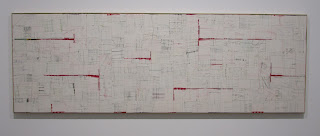+
"I believe that all women should like their bodies and use them as tools of seduction" - Ghada Amer.
Quite the provocative statement by Amer above, whose artistic career has been built on frank representations of female sexuality on canvas. It's quite a timely statement too given the attacks on the female body leading to the #MeToo movement, and the current outrage in America as the US Supreme Court seeks to overturn the landmark Roe v Wade ruling in favour of a woman's right to choose an abortion in circumstances such as rape. Not surprisingly this erosion of a woman's rights to her own body and reproductive rights has been met with much resistance. President Joe Biden has waded into the debate promising to "be ready when any ruling is issued to fight the attack on reproductive rights." Amer states - "In Western societies, there is an assumption, especially among younger generations, that the battle of the sexes has been won, that women have been liberated, and that their rights are secure. And yet, we are witnessing today a sharp regression of women's rights and a stark rise of violence against women. However, in countries where one assumes women's rights to be limited or absent, such as in Egypt, Iran, Afghanistan, or Mexico, women of the younger generation know they have a lot to gain from fighting for those very same rights that are eroding in the West." The canvases here depict women totally at comfort in their bodies and sensuality, but are not as explicit as previous canvases. The typographic canvases contain phrases which relate to teachings on women's rights from both male and female authors that reassert the need for women to never relinquish their rights to their bodies. This is Amer's first solo show in London in twenty years, and my decided and overriding interest was, like myself, her being an artist who also employs textiles techniques to stitch pictorial depictions into a ground/support. The exhibition comprises ceramics, embroidered canvases, and sculptures. I enjoyed the ways in which the linear, bronze sculptures of women in certain stages of undress played with, and cast shadows and differing perspectives under certain lights. Perhaps the most surprising aspect of Amer's practice to me was that which involved her designing and creating gardens. It was really inspiring to see the installation of an array of planters filled with flowers spelling out the title of the exhibition in the gallery space. I thought this was a particularly beautiful and poignant manifestation of Amer's art which spoke of a sense of peace and reconciliation.
Remy Jungerman: Fault Lines













































No comments:
Post a Comment